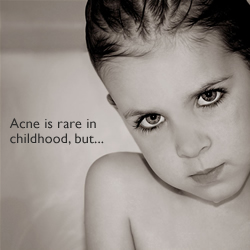Childhood Acne
Acne in childhood is not a normal pattern of presentation of acne. However, adolescent acne has become quite common in older children in the 8-12 age group, leading to a move to differentiate childhood acne from pre-teen acne. Cases of acne in children require medical investigation in order both to identify the cause of the acne and to provide appropriate treatment.
Definition of Childhood Acne
Childhood is the period of life which falls between infancy and adolescence. The developmental progression baby - child - adolescent dovetails neatly with the concept of the clinical types of acne. The incidence of acne is extremely low in the period between infancy and adolescence Infantile acne is the predominant clinical type of acne in infancy, whilst adolescent acne, caused by the hormonal changes associated with puberty, has a strong association with adolescence. There aren't any clinical types of acne which are preferentially associated with childhood, so the incidence of acne is very low in the period between infancy and adolescence. However, preserving the clinical relationship when defining acne age distribution types requires a little bit of trickery. Infancy is a fixed period of time, defined arbitrarily by doctors as the first 12, 18 or 24 month of life. In contrast, adolescence is a moveable feast. Adolescence is the period which marks the transition from child to adult, encompassing both the physical changes of puberty and the more prolonged period of development to intellectual and emotional maturity. There is considerable variation in the age of onset of adolescence and its duration, not just between individuals, but also between cultures and during different periods of history. Turn the clock back two or three generations and there was a good correlation between clinical adolescence and the chronological teenage period. However, the average age of the onset of puberty has dropped gradually, but inexorably, over the course of the last century so that the relationship between teenage and adolescence no longer holds true. To accommodate the lowering in the average age of adolescence, an additional acne age distribution group is required, pre-teen acne, which is the development of acne in someone aged between 8 and 12. After conducting this bit of jiggery-pokery, one can define childhood acne as the development of acne in a child aged between one and eight years of age.
Causes of Acne in Children

Childhood acne is rare, because children ordinarily have inactive sebaceous glands and are therefore missing one of the key ingredients, seborrhoea, implicated in the development of acne spots. Sebaceous glands become active during puberty, stimulated by the same sex hormones which cause the development of the external genitalia and other physical changes associated with puberty. The commonest clinical type of acne in childhood is still adolescent acne, though of 'pathological type'. In terms of the type and distribution of spots, the presentation of adolescent acne is the same in teenagers and children. However, whilst adolescent acne is a normal occurrence in pre-teens and teenagers, it is abnormal in a child and requires urgent investigation. Many cases of adolescent acne in children will be associated with pathological precocious puberty - the early onset of puberty caused by an underlying medical condition, either an endocrine disorder or a hormone-producing tumour. Child acne may be caused by other clinical types of acne, but drug-induced acne is the only type responsible for a significant number of cases. Parents should have been informed if their child has been prescribed medication which causes acne as a side-effect and will usually be alert to the possibility that the acne is drug-induced.
Significance of Acne in Children
Acne in children is not normal and should be treated seriously. It is imperative that the child is examined by a doctor and the underlying cause of the acne identified. Following an initial consultation with a General Practitioner, it is likely that the child will need to be referred to a specialist, who can investigate and treat the underlying condition which has caused the acne.